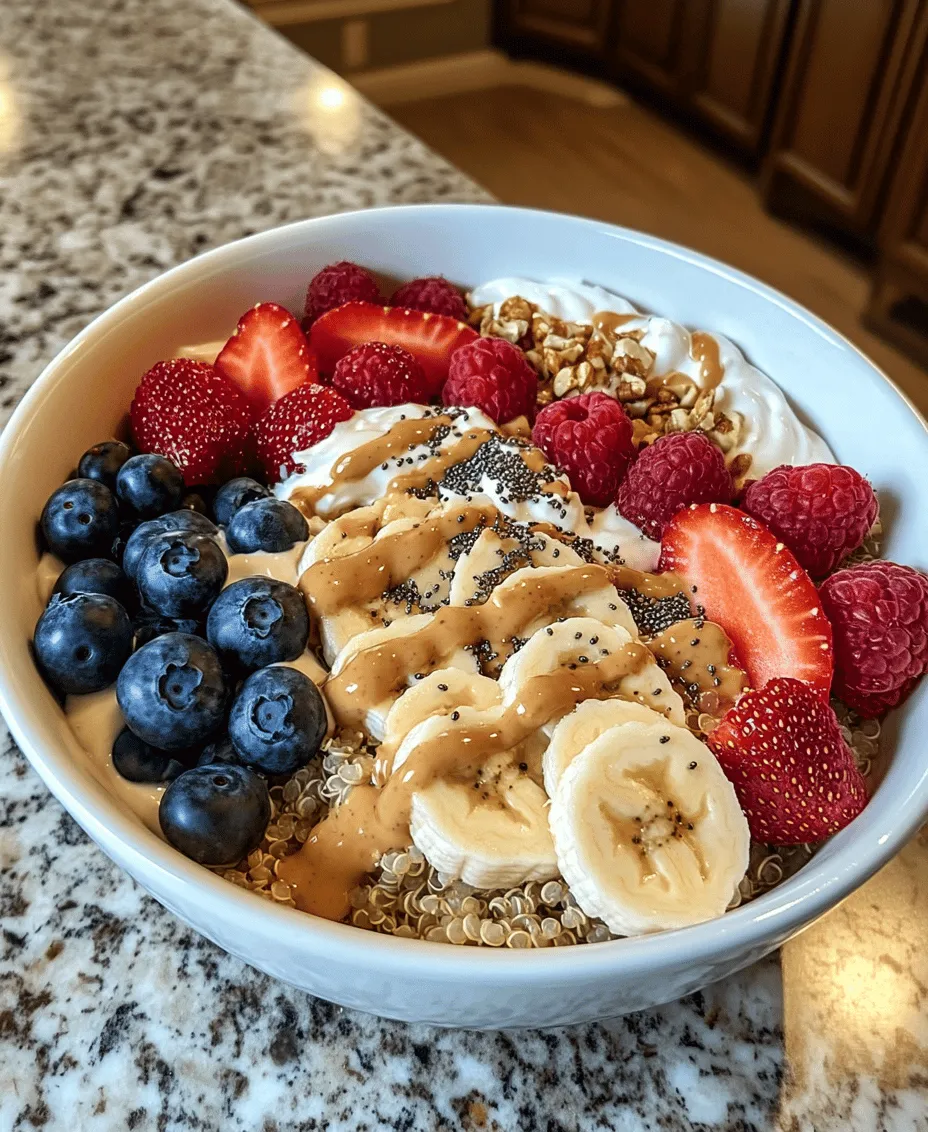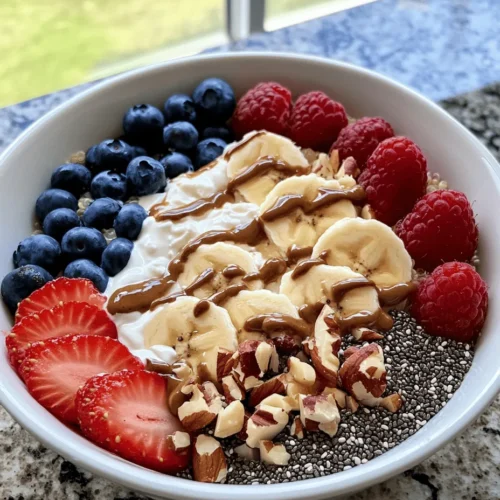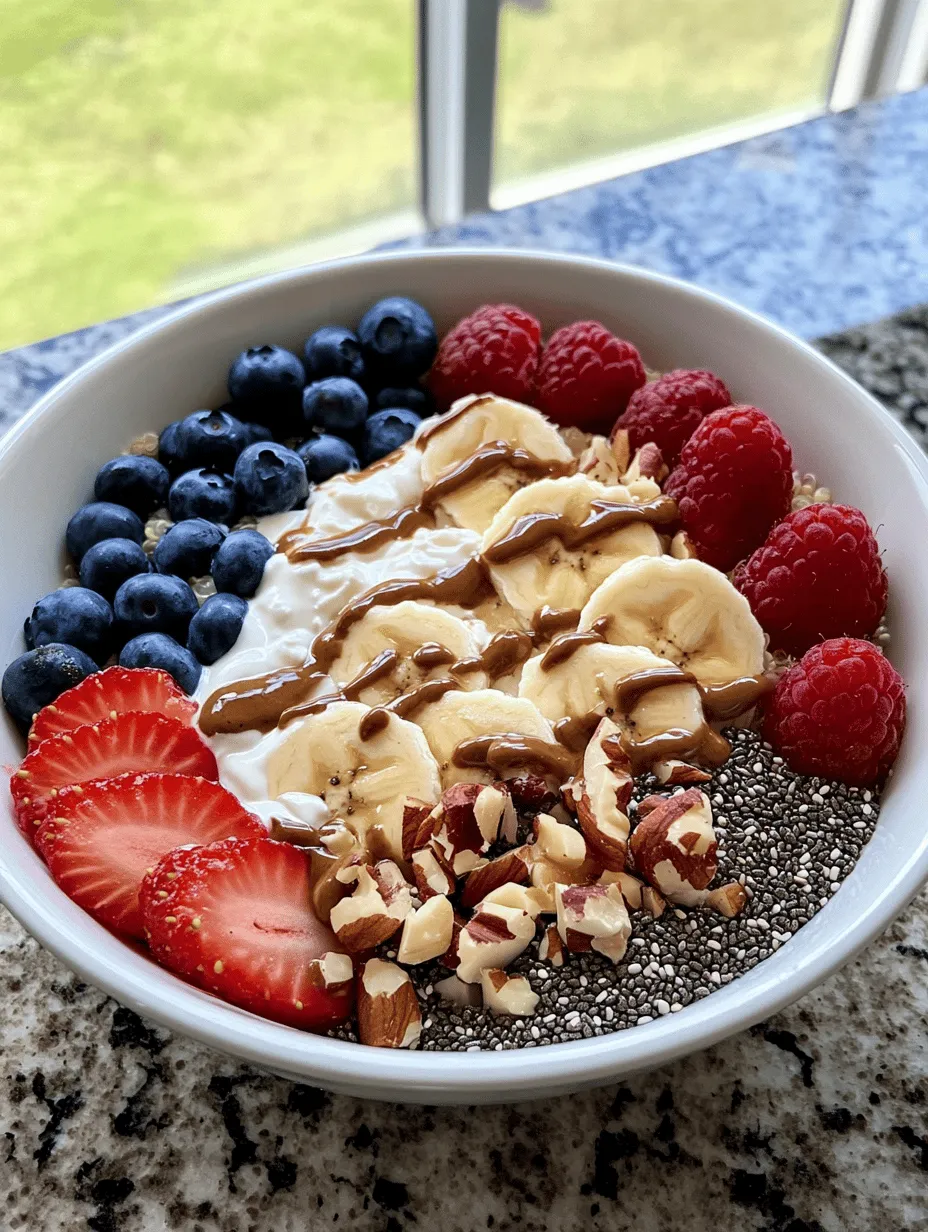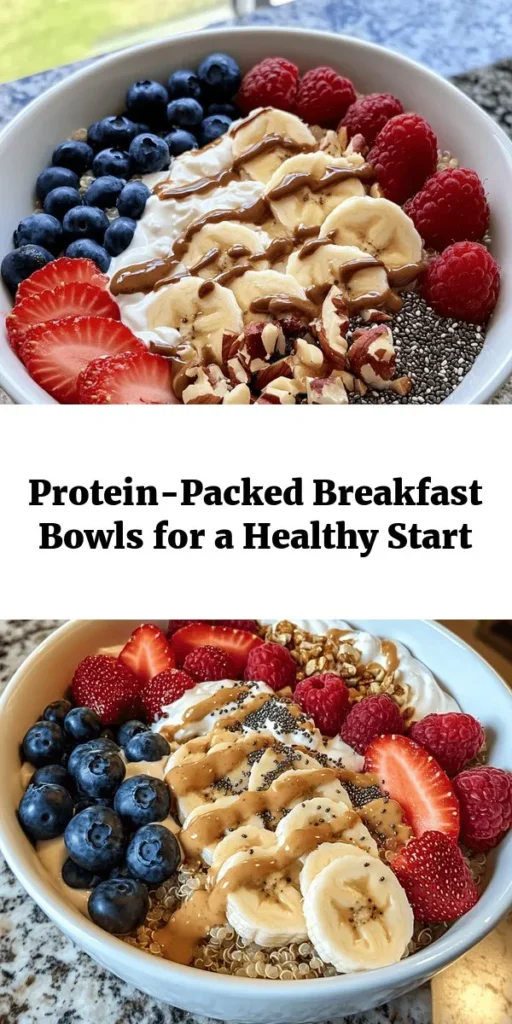Introduction
Starting your day with a nutritious breakfast is essential for maintaining energy levels, enhancing cognitive function, and setting the tone for healthy eating throughout the day. A well-balanced breakfast not only fuels your body after a long night of fasting but also plays a crucial role in stabilizing blood sugar levels and preventing mid-morning cravings. Among the myriad of breakfast options available, high-protein breakfast bowls have emerged as a popular choice for health-conscious individuals.
High-protein breakfast bowls combine various ingredients that are rich in protein, making them an ideal meal to kickstart your day. These bowls are not only versatile and easy to prepare, but they also offer an array of health benefits, from promoting muscle repair to providing sustained energy. Including protein in your breakfast can help you feel fuller for longer, curb those pesky hunger pangs, and support your overall fitness goals. Whether you’re an athlete looking for muscle recovery or simply someone wanting to maintain a healthy lifestyle, these breakfast bowls can cater to your nutritional needs.
In this article, we will delve into the nutritional benefits of each ingredient used in high-protein breakfast bowls and provide you with a step-by-step guide to creating your very own delicious, nutrient-packed meals. Say goodbye to bland breakfasts and hello to a vibrant, satisfying start to your day!
Understanding the Nutritional Benefits of Each Ingredient
Greek Yogurt: A Powerhouse of Protein and Probiotics
Greek yogurt is a staple in many high-protein breakfast bowls, and for good reason. This creamy dairy product is packed with protein, typically containing around 15-20 grams of protein per 6-ounce serving. Greek yogurt is also a great source of probiotics, which are beneficial bacteria that support gut health. With its thick texture and tangy flavor, Greek yogurt not only enhances the creaminess of your breakfast bowl but also provides a nutritional boost that keeps you feeling full and satisfied.
Quinoa: The Super Grain That Boosts Protein and Fiber Intake
Quinoa is often labeled as a superfood, and it deserves that title. This ancient grain is unique in that it contains all nine essential amino acids, making it a complete protein source. A single cup of cooked quinoa offers about 8 grams of protein and 5 grams of fiber, which can aid in digestion and promote a feeling of fullness. Quinoa is also gluten-free, making it an excellent option for those with gluten sensitivities. Adding quinoa to your high-protein breakfast bowl not only elevates the protein content but also introduces a delightful nutty flavor and a satisfying texture.
Cottage Cheese: Low-Fat Protein Packed with Calcium
Cottage cheese is another fantastic option for those looking to increase their protein intake. With approximately 27 grams of protein in just one cup, this dairy product is a low-fat powerhouse. Cottage cheese is also rich in calcium, which is essential for maintaining bone health. Its mild flavor and lumpy texture make it a versatile ingredient that can be paired with both sweet and savory components in your breakfast bowl, enhancing both nutrition and taste.
Bananas: A Source of Natural Sweetness and Potassium
No breakfast bowl would be complete without the addition of fruit, and bananas are a favorite choice. These tropical fruits provide natural sweetness, making them a perfect complement to the other ingredients in your bowl. Bananas are also packed with potassium, an essential mineral that helps regulate blood pressure and maintain proper muscle function. Their creamy texture adds a delightful dimension to your breakfast bowl while providing dietary fiber to support digestive health.
Mixed Berries: Antioxidant-Rich Fruits for Added Vitamins
Mixed berries, such as blueberries, strawberries, and raspberries, are a colorful and nutritious addition to any high-protein breakfast bowl. These fruits are rich in antioxidants, which help combat oxidative stress and inflammation in the body. Additionally, berries are low in calories and high in vitamins, minerals, and fiber, making them a smart choice for weight management and overall health. Their vibrant colors and natural sweetness not only enhance the visual appeal of your breakfast bowl but also contribute essential nutrients that support your immune system.
Nut Butters: Healthy Fats and Additional Protein Sources
Nut butters, such as almond or peanut butter, offer a delicious way to incorporate healthy fats into your high-protein breakfast bowl. These spreads are not only rich in protein but also contain heart-healthy monounsaturated fats that can help improve cholesterol levels. A tablespoon of nut butter typically provides around 3-4 grams of protein, along with essential vitamins and minerals like vitamin E and magnesium. The creamy texture and rich flavor of nut butter elevate your breakfast bowl while providing sustained energy that keeps you feeling satisfied.
Chia Seeds: Tiny Seeds Loaded with Omega-3 Fatty Acids and Fiber
Chia seeds may be small, but they pack a nutritional punch. These tiny seeds are loaded with omega-3 fatty acids, which are essential for brain health and reducing inflammation in the body. Additionally, chia seeds are an excellent source of fiber, providing about 11 grams per ounce. When added to your high-protein breakfast bowl, chia seeds absorb liquid and expand, creating a satisfying pudding-like texture. Their mild flavor allows them to blend seamlessly with other ingredients, making them a fantastic addition to boost the nutritional profile of your meal.
Honey/Maple Syrup: Natural Sweeteners and Their Health Benefits
To add a touch of sweetness to your high-protein breakfast bowl, consider using natural sweeteners like honey or maple syrup. Both options provide a healthier alternative to refined sugars, offering a range of vitamins and minerals. Honey is known for its antimicrobial properties and can soothe sore throats, while maple syrup contains antioxidants that may help reduce inflammation. When used in moderation, these natural sweeteners can enhance the flavor of your breakfast bowl without compromising your health goals.
Nuts: Crunchy Protein Sources That Enhance Flavor and Texture
Nuts are a versatile and nutritious addition to any breakfast bowl. They are a great source of protein, healthy fats, and essential nutrients. Almonds, walnuts, and pecans are popular choices, each providing a unique flavor and texture that can elevate your meal. A small handful of nuts can add approximately 5-6 grams of protein, along with beneficial compounds like vitamin E and magnesium. The crunchiness of nuts provides a satisfying contrast to the creaminess of yogurt and the softness of fruit, creating a delightful balance in your high-protein breakfast bowl.
Step-by-Step Guide to Preparing High-Protein Breakfast Bowls
Now that we’ve explored the incredible nutritional benefits of each ingredient, it’s time to dive into the step-by-step process of creating your high-protein breakfast bowl. This recipe is customizable, allowing you to mix and match ingredients based on your preferences and dietary needs. Whether you prefer a sweet, fruity bowl or a savory, hearty option, these steps will guide you in crafting the perfect breakfast.
Step 1: Gather Your Ingredients
Start by gathering all the ingredients you want to include in your high-protein breakfast bowl. Here’s a basic list to get you started:
– 1 cup Greek yogurt or cottage cheese
– ½ cup cooked quinoa
– 1 ripe banana, sliced
– ½ cup mixed berries (fresh or frozen)
– 1 tablespoon nut butter (almond, peanut, or your choice)
– 1 tablespoon chia seeds
– Drizzle of honey or maple syrup (to taste)
– A handful of nuts (almonds, walnuts, or your choice)
Feel free to adjust the quantities based on your hunger level or personal preferences.
Step 2: Prepare the Base
In a medium-sized bowl, start by adding your choice of Greek yogurt or cottage cheese. This will serve as the base of your breakfast bowl and provide the primary source of protein. If you’re using Greek yogurt, consider adding a splash of milk or water to achieve your desired consistency—thicker for a spoonable bowl or thinner for a more smoothie-like texture.
Next, add the cooked quinoa. If you haven’t prepared quinoa yet, simply rinse 1 cup of dry quinoa, then cook it according to package instructions—typically, this involves boiling it in water until fluffy. Once cooked, allow it to cool slightly before mixing it into your yogurt base.
Step 3: Layer Your Ingredients
Once you have your base ready, it’s time to layer in the toppings. Start by adding the sliced banana on top of your yogurt and quinoa mixture. The banana will add natural sweetness and a creamy texture that complements the other ingredients beautifully.
Next, sprinkle the mixed berries over the bowl. If you’re using frozen berries, there’s no need to thaw them—simply add them directly on top. The berries will create a burst of color and antioxidants in your breakfast bowl.
Step 4: Add Nut Butter and Chia Seeds
Drizzle your choice of nut butter over the layered ingredients. This not only enhances the flavor profile but also adds healthy fats and protein. You can either swirl it in or leave it as a topping.
Finally, sprinkle chia seeds over the top. These tiny seeds will add a nutritional boost and a pleasant crunch, making your breakfast bowl even more satisfying.
Step 5: Sweeten and Garnish
To finish off your high-protein breakfast bowl, drizzle a small amount of honey or maple syrup over the top, adjusting the sweetness to your liking. If desired, add a handful of your favorite nuts for added crunch and flavor.
With the combination of creamy yogurt, protein-packed quinoa, sweet fruits, and crunchy nuts, your high-protein breakfast bowl is now ready to enjoy! This nutrient-dense meal will not only keep you satiated throughout the morning but also provide a delicious start to your day.
Stay tuned for the next part of this article, where we will explore additional variations of high-protein breakfast bowls and answer some common questions about this versatile meal.

Preparation Time and Serving Size
When it comes to healthy meal preparation, timing is everything. For high-protein breakfast bowls, you can expect a preparation time of approximately 15 minutes, with an additional 20 minutes for cooking the quinoa. This means you can whip up a nutritious breakfast in about 35 minutes. This recipe typically serves 2, making it perfect for sharing with a loved one or preparing an extra serving for the next day.
Cooking Quinoa: Tips for Perfect Texture
Quinoa serves as the hearty base for your breakfast bowl, and achieving the perfect texture is essential for a satisfying meal. Start by rinsing 1 cup of quinoa under cold water in a fine mesh strainer. This step is crucial, as it removes the natural coating called saponin, which can impart a bitter taste.
Once rinsed, combine the quinoa with 2 cups of water or low-sodium vegetable broth in a medium saucepan. Bring the mixture to a boil over high heat. After it reaches a boil, reduce the heat to low, cover the saucepan, and let it simmer for about 15 minutes. Avoid lifting the lid during cooking, as this can release steam and hinder the cooking process.
Once the quinoa is cooked and has absorbed all the liquid, remove it from heat and let it sit, covered, for an additional 5 minutes. This resting time allows the quinoa to steam and become fluffy. Finally, fluff the quinoa with a fork before serving, ensuring each grain is separate and light.
Layering Basics: Building the Ultimate Breakfast Bowl
The beauty of breakfast bowls lies in their versatility and the layers of flavor and nutrition you can create. Begin with a generous scoop of your fluffy quinoa as the base. From here, the layering possibilities are endless:
1. Protein Source: Add a protein-rich element to your bowl. Options include scrambled eggs, Greek yogurt, or tofu scramble for a plant-based alternative.
2. Fruits and Vegetables: Next, pile on fresh fruits like sliced bananas, berries, or diced apples. For veggies, consider adding spinach, cherry tomatoes, or even roasted sweet potatoes.
3. Healthy Fats: Incorporate a source of healthy fats, such as avocado slices, a dollop of nut butter, or a sprinkle of seeds like chia or pumpkin seeds.
4. Flavor Boosters: Drizzle with a natural sweetener like honey or maple syrup, or sprinkle cinnamon and nutmeg for an aromatic touch.
5. Crunch Factor: Top it all off with some crunchy granola or nuts for added texture.
Creative Ways to Customize Your Bowl: Variations Based on Dietary Needs or Preferences
One of the best aspects of high-protein breakfast bowls is their adaptability. Here are several creative variations to cater to different dietary needs:
– Vegan-Friendly: Use silken tofu or chickpeas instead of eggs, and opt for almond milk yogurt to keep it plant-based.
– Gluten-Free: Quinoa is naturally gluten-free, making it an excellent choice for those with gluten sensitivities. Just ensure any additional ingredients, such as granola, are certified gluten-free.
– Paleo Option: Swap out grains for cauliflower rice or extra veggies, and focus on whole foods such as eggs, avocado, and nuts.
– Low-Carb Version: Reduce the quantity of quinoa and increase the vegetables in your bowl. Leafy greens and cruciferous vegetables like broccoli or cauliflower can add bulk without the carbs.
Flavor Enhancements and Additions
Exploring Different Nut Butters: Almond vs. Peanut and Their Flavor Profiles
Nut butters are a fantastic way to introduce healthy fats and protein into your breakfast bowl. Almond butter offers a slightly sweeter, more delicate flavor compared to peanut butter’s robust, earthy notes. Consider the texture as well; almond butter is usually creamier, while peanut butter can have a chunkier consistency.
Experimenting with different nut butters can completely change the flavor profile of your breakfast bowl. For an exotic twist, try cashew butter or sunflower seed butter for those with nut allergies. Each nut butter brings its unique taste and nutritional benefits, making it easy to switch things up daily.
Sweetening Options: Natural vs. Refined Sugars
When it comes to sweetening your high-protein breakfast bowl, opting for natural sweeteners is a healthier choice. Raw honey, maple syrup, or agave nectar can enhance the flavor without the drawbacks of refined sugars. Additionally, consider using mashed bananas or applesauce as natural sweeteners that add moisture and a subtle sweetness to the bowl.
Spices in Breakfast: The Role of Cinnamon and Other Spices in Enhancing Flavor and Health Benefits
Spices can elevate your breakfast bowl both in flavor and health benefits. Cinnamon, in particular, is a powerhouse spice that not only adds warmth and sweetness but also has anti-inflammatory properties. Other spices like ginger or nutmeg can also introduce unique flavor dimensions. Experimenting with spice blends can make your breakfast both delicious and beneficial to your overall wellness.
Seasonal Variations: Adapting the Recipe with Seasonal Fruits and Ingredients
Seasonal fruits and ingredients not only enhance the freshness of your breakfast bowl but also provide a diverse range of flavors throughout the year. In the summer, opt for juicy peaches, berries, or watermelon. Fall brings opportunities for apples, pears, and pumpkin puree. Winter is perfect for citrus fruits like oranges or grapefruits, while spring can introduce fresh berries and rhubarb. Incorporating seasonal ingredients not only diversifies your flavors but also supports local produce.
Making It a Meal Prep Favorite
How to Prepare Components Ahead of Time for Busy Mornings
For those busy mornings when time is of the essence, meal prepping can be a lifesaver. Cook a large batch of quinoa at the beginning of the week and store it in the refrigerator. It will keep well for up to five days. You can also pre-chop your favorite fruits and vegetables and store them in airtight containers. This way, when morning rolls around, all you need to do is layer the ingredients in your bowl.
Storage Tips for Keeping Ingredients Fresh
To maintain the freshness of your prepped ingredients, store them in separate airtight containers. Quinoa can be refrigerated, but fruits and vegetables are best kept in the crisper drawer of your fridge. To prevent browning, consider adding a little lemon juice to cut fruits like apples or bananas.
Portion Control and Serving Suggestions for Meal Prep
When it comes to portion control, consider investing in meal prep containers with compartments. This allows you to pack your quinoa, protein source, and toppings separately, so everything stays fresh and delicious. A good serving size for your breakfast bowl is about 1/2 cup of quinoa, 1 egg or equivalent protein source, and a generous handful of fruits and vegetables.
Conclusion
High-protein breakfast bowls are a versatile, nutritious, and delicious way to start your day. They offer a wealth of health benefits, including sustained energy, improved satiety, and a balanced intake of macronutrients. The flexibility of these bowls allows you to tailor them to your tastes and dietary needs, making breakfast something to look forward to.
We encourage you to experiment with flavors, textures, and ingredients, allowing your creativity to shine as you craft your personalized breakfast masterpiece. By incorporating high-protein breakfasts into your daily routine, you not only enhance your energy levels but also set a positive tone for your entire day. Embrace the power of breakfast bowls and discover how they can transform your mornings into a nourishing and enjoyable experience.



